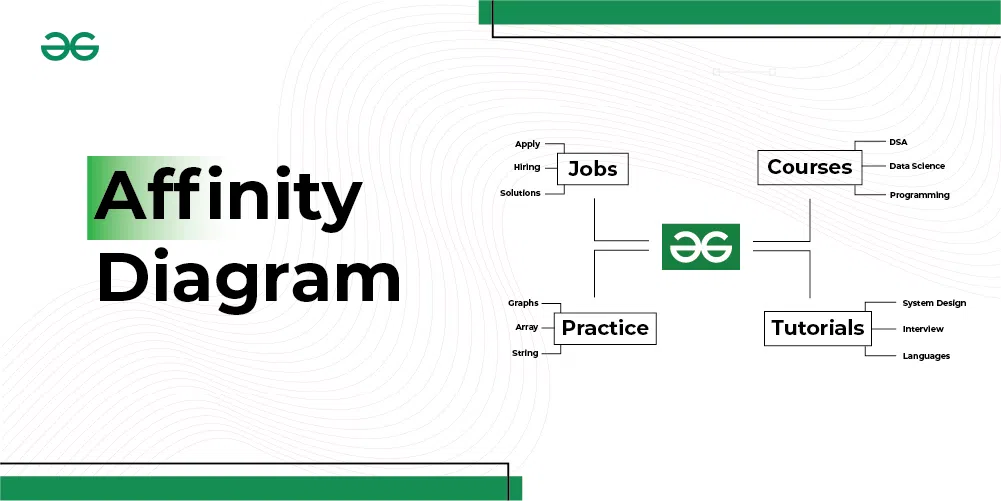What Is an Affinity Diagram?
Last Updated :
30 Nov, 2023
An Affinity Diagram, also known as the KJ Method (Kawakita Jiro Method), is a brainstorming and organization technique used to gather and categorize large amounts of information, ideas, or data into meaningful groups or themes. It was developed by Jiro Kawakita, a Japanese anthropologist, as a way to manage and make sense of qualitative data. It is particularly useful in situations where there is a need to make sense of a complex and unstructured set of information.

Affinity Diagram
Types of Affinity Diagrams
The traditional Affinity Diagram technique doesn’t have distinct types, but it can be adapted for various purposes. Some variations and related techniques include:
- Tree Diagram: A hierarchical structure that organizes ideas into a tree-like diagram, with a central idea or problem at the root and branches representing subtopics or categories.
- Affinity Matrix: In cases where quantitative data needs to be organized, an affinity matrix can be used. It involves creating a table or matrix where data points are compared and categorized based on similarities.
- Hybrid Methods: Some practitioners combine the Affinity Diagram with other problem-solving or decision-making techniques like the Fishbone Diagram (Ishikawa Diagram) to address specific issues more effectively.
While the basic principles of the Affinity Diagram remain consistent, the way it is implemented can vary depending on the context and the nature of the information being organized.
How to Create an Affinity Diagram
- Gather Data: Collect all relevant ideas, data points, or facts on individual cards or sticky notes.
- Sort and Categorize: Lay out all the cards on a large surface, like a whiteboard or table. Begin sorting the cards into groups that share common themes or relationships.
- Label Categories: As groups emerge, label them to reflect the central theme or category they represent.
- Review and Refine: Review the diagram with the team, and make adjustments as needed to ensure the groupings accurately represent the data.
- Document and Use: Once the affinity diagram is complete, it can serve as a reference for making informed decisions, solving problems, or planning projects.
Uses of Affinity Diagram
- Brainstorming and Idea Generation: Teams can use affinity diagrams to collect and categorize ideas generated during brainstorming sessions. This helps identify common themes and patterns, which can lead to innovative solutions.
- Problem Solving and Root Cause Analysis: When facing complex problems, teams can use affinity diagrams to gather information and identify the root causes of issues. This is essential for effective problem resolution.
- Project Planning: During project planning, teams can use affinity diagrams to organize tasks, risks, or project requirements into logical groups. This aids in structuring the project and identifying dependencies.
- User Research and Feedback Analysis: Affinity diagrams are valuable in user research to categorize user feedback, comments, and observations. This allows product teams to identify trends and prioritize improvements.
Benefits of Affinity Diagrams
- Structured Information: Affinity diagrams help in structuring and organizing unstructured information or ideas, making it easier to analyze and draw insights from the data.
- Team Collaboration: They encourage team collaboration, as members can collectively group and label data points, fostering a shared understanding of the information.
- Visual Representation: Affinity diagrams provide a visual representation of data, which is often easier for people to grasp and work with compared to lists or unorganized data.
- Identification of Patterns and Insights: Affinity diagrams reveal patterns, trends, and insights within the data that might not be apparent when looking at individual data points.
- Data-Driven Decision Making: They support data-driven decision making by organizing information in a way that allows teams to prioritize and address issues or opportunities systematically.
Limitations of Affinity Diagrams
While affinity diagrams are a valuable tool for organizing and structuring ideas and data, they do have some limitations:
- Subjectivity: The process of creating an affinity diagram relies on the interpretation and categorization of data by individuals, making it subjective. Different people may categorize the same data differently.
- Time-Consuming: Creating an affinity diagram can be a time-consuming process, especially when dealing with a large amount of data or ideas.
- Overgeneralization: The process of grouping items together may lead to overgeneralization, where specific nuances and details can get lost.
- Lack of Quantification: Affinity diagrams don’t provide a way to quantify the importance or relevance of each item within a category. This can make it challenging to prioritize ideas or issues.
- Limited to Post: It Notes: In its traditional form, affinity diagrams are created using physical Post-It notes, which may not be practical for remote teams or when dealing with digital data.
Examples of Affinity Diagrams
Here are a couple of examples to illustrate how affinity diagrams can be used:
- Product Development: In a product development team, members might use an affinity diagram to organize user feedback and feature requests. This can help identify common themes and prioritize which features to work on next.
- Problem-Solving: In a business context, a team facing a complex problem may use an affinity diagram to categorize the causes and potential solutions. This can help the team identify root causes and generate innovative ideas for solving the problem.
Conclusion
Affinity diagrams are powerful tools for sense-making, problem-solving, and decision-making. They help teams and individuals make sense of complex and unstructured information by grouping related ideas or data together, revealing patterns, themes, and potential solutions. While they have their limitations, such as subjectivity and the time-consuming nature of the process, when used effectively, affinity diagrams can lead to more informed and organized decision-making processes.
Share your thoughts in the comments
Please Login to comment...